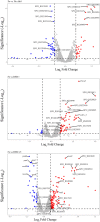Effects of iron concentration and DFB (Desferrioxamine-B) on transcriptional profiles of an ecologically relevant marine bacterium
- PMID: 38100448
- PMCID: PMC10723695
- DOI: 10.1371/journal.pone.0295257
Effects of iron concentration and DFB (Desferrioxamine-B) on transcriptional profiles of an ecologically relevant marine bacterium
Abstract
Research into marine iron cycles and biogeochemistry has commonly relied on the use of chelators (including siderophores) to manipulate iron bioavailability. To test whether a commonly used chelator, desferrioxamine B (DFB) caused effects beyond changing the iron-status of cells, cultures of the environmentally relevant marine heterotrophic bacterium, Ruegeria pomeroyii, were grown in media with different concentrations of iron and/or DFB, resulting in a gradient of iron availability. To determine how cells responded, transcriptomes were generated for cells from the different treatments and analyzed to determine how cells reacted to these to perturbations. Analyses were also performed to look for cellular responses specific to the presence of DFB in the culture medium. As expected, cells experiencing different levels of iron availability had different transcriptomic profiles. While many genes related to iron acquisition were differentially expressed between treatments, there were many other genes that were also differentially expressed between different sample types, including those related to the uptake and metabolism of other metals as well as genes related to metabolism of other types of molecules like amino acids and carbohydrates. We conclude that while DFB certainly altered iron availability to cells, it also appears to have had a general effect on the homeostasis of other metals as well as influenced metabolic processes outside of metal acquisition.
Copyright: © 2023 LeCleir et al. This is an open access article distributed under the terms of the Creative Commons Attribution License, which permits unrestricted use, distribution, and reproduction in any medium, provided the original author and source are credited.
Conflict of interest statement
The authors have declared that no competing interests exist.
Figures




Similar articles
-
Transcriptomic analysis of the effect of deferoxamine exposure on the growth, photosynthetic activity and iron transfer of Microcystis aeruginosa.Chemosphere. 2023 Jun;327:138506. doi: 10.1016/j.chemosphere.2023.138506. Epub 2023 Mar 24. Chemosphere. 2023. PMID: 36966924
-
Iron acquisition in the marine actinomycete genus Salinispora is controlled by the desferrioxamine family of siderophores.FEMS Microbiol Lett. 2012 Oct;335(2):95-103. doi: 10.1111/j.1574-6968.2012.02641.x. Epub 2012 Aug 14. FEMS Microbiol Lett. 2012. PMID: 22812504 Free PMC article.
-
Structure-based differences between the metal ion selectivity of two siderophores desferrioxamine B (DFB) and desferricoprogen (DFC): why DFC is much better Pb(II) sequestering agent than DFB?J Inorg Biochem. 2008 Aug;102(8):1654-9. doi: 10.1016/j.jinorgbio.2008.03.006. Epub 2008 Apr 1. J Inorg Biochem. 2008. PMID: 18486225
-
Comparative efficacy and toxicity of desferrioxamine, deferiprone and other iron and aluminium chelating drugs.Toxicol Lett. 1995 Oct;80(1-3):1-18. doi: 10.1016/0378-4274(95)03415-h. Toxicol Lett. 1995. PMID: 7482575 Review.
-
Chelators at the cancer coalface: desferrioxamine to Triapine and beyond.Clin Cancer Res. 2006 Dec 1;12(23):6876-83. doi: 10.1158/1078-0432.CCR-06-1954. Clin Cancer Res. 2006. PMID: 17145804 Review.
References
-
- Martin JH, Gordon RM. Northeast Pacific iron distributions in relation to phytoplankton productivity. Deep-sea Res 1988; 35:177–196.
-
- Martin JH, Fitzwater SE. Iron deficiency limits phytoplankton growth in the north-east pacific subarctic. Nature. 1988; 331:41–43. - PubMed
-
- Martin JH. Glacial-interglacial CO2 change: The Iron Hypothesis. Paleoceanography. 1990; 5:1–13.
MeSH terms
Substances
LinkOut - more resources
Full Text Sources
Medical
Research Materials

